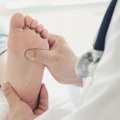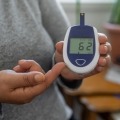Recently Screened for Kidney Disease? Now What?
By Jimmy McDermott
 Regular testing of kidney health is important for people with diabetes, but it can be difficult to navigate your test results. Learn how to understand your tests, work with your healthcare team, and protect your kidney health in the long run.
Regular testing of kidney health is important for people with diabetes, but it can be difficult to navigate your test results. Learn how to understand your tests, work with your healthcare team, and protect your kidney health in the long run.
Diabetes is one of the leading causes of kidney disease and kidney failure. Over time, high blood sugar can damage the blood vessels in the kidneys, leading to kidney damage. As such, the National Kidney Foundation (NKF) and American Diabetes Association (ADA) recommend that people with diabetes are tested at least once per year. This testing will provide important information on your kidney health. But how do you put all that information into action?
Click to jump down:
-
How can you advocate for yourself to get the care that you need?
-
What to expect from your doctor when talking about your results
How do doctors test kidney health?
The two most common tests of kidney damage and kidney function are:
-
Urine albumin-to-creatine ratio (UACR): this urine test checks for kidney damage by looking for albumin (a type of protein) found in urine. In healthy kidneys, there will likely be no albumin detected. If there is albumin in the urine (also called albuminuria), it is likely that the kidney’s filtering ability has been damaged.
-
Estimated glomerular filtration rate (eGFR): this blood test checks for kidney function by estimating your kidney’s filtering ability. This test measures the amount of creatinine (a waste product normally cleared by the kidneys) in your blood and takes into consideration factors like age, body size, and gender. A decrease in your eGFR level suggests that your kidney’s may not be working properly.
.png) Key point: Pam Kushner MD, a clinical professor of Family Medicine for the University of California at Irvine, said that it is important to make sure your doctor tests both your UACR and eGFR. A recent study showed that eGFR was tested in almost 88% of people with type 2 diabetes, while UACR was tested in only 53% of people with type 2 diabetes. Many doctors may only test eGFR because it is included in the “Basic Chemistry Panel” that is completed whenever your healthcare professional does that bloodwork. But because your UACR can show signs of kidney damage even before eGFR is lowered, ask your doctor to test it as well.
Key point: Pam Kushner MD, a clinical professor of Family Medicine for the University of California at Irvine, said that it is important to make sure your doctor tests both your UACR and eGFR. A recent study showed that eGFR was tested in almost 88% of people with type 2 diabetes, while UACR was tested in only 53% of people with type 2 diabetes. Many doctors may only test eGFR because it is included in the “Basic Chemistry Panel” that is completed whenever your healthcare professional does that bloodwork. But because your UACR can show signs of kidney damage even before eGFR is lowered, ask your doctor to test it as well.
Note: Many diagnostic measures, including eGFR, use factors such as race and ethnicity to adjust a person's evaluation. These adjustments have no genetic or medical basis and are rooted in discriminatory and outdated healthcare systems. Please ask your healthcare professional how adjustments to your eGFR may affect your care.
To learn more about screening for kidney health, check out our recent article, “Let’s Talk About Getting Screened for Kidney Disease.”
UACR: A UACR level of more than 30 mg/g is a marker for kidney disease (microalbuminuria). This can be an early sign of kidney damage and may occur before eGFR declines. It is also important to note that sometimes people with kidney disease will not have albumin in the urine. Therefore, eGFR should also be measured in all adults with diabetes.
eGFR: According to the National Kidney Foundation, the standard eGFR for a young person is 90 ml/min/1.73m2 or higher. eGFR does slowly decline as you get older even without any disease. Someone who has an eGFR below 60 ml/min/1.73m2 for at least three months is considered to have kidney disease. eGFR is also used to classify kidney disease into five stages of severity:
-
Stage 1: eGFR of 90 or higher. If you are classified with Stage 1 kidney disease, it means that you exhibited other signs of kidney damage (such as an elevated UACR or physical damage to your kidneys) but you still have normal kidney function
-
Stage 2: eGFR of 89-60. There has been mild loss of kidney function.
-
Stage 3a: eGFR of 59-45. There has been mild to moderate loss of kidney function.
-
Stage 3b: eGFR of 44-30. There has been moderate to severe loss of kidney function.
-
Stage 4: eGFR of 29-15. There has been a severe loss of kidney function.
-
Stage 5: eGFR of less than 15. This stage represents kidney failure.
What questions should you ask your doctor?
-
Am I at risk for kidney disease? Dr. Kushner said, “If you have diabetes, high blood pressure (hypertension), obesity, coronary artery disease (heart disease), a family history of kidney disease, or if you smoke, then you are at risk.” People who smoke are more likely to have protein in their urine. Certain illegal and legal drugs could also increase your risk.
-
Can you test my kidney function? If you are at risk, ask your doctor to test your kidney function. It is important to test both UACR and eGFR at least once per year.
-
What is my risk of progression of kidney disease based on my eGFR and UACR? The figure below is the Kidney Disease: Improving Global Outcomes (KDIGO) chart used to show the risk of progression of kidney disease. On the left side, you see eGFR. On the top, you see urine albumin levels. Higher albumin levels and lower eGFR shows that there is a greater chance of progressing to end-stage renal disease (ESRD).
.png)
The risk of progression of kidney disease increases from green to yellow to orange to red in the chart above.
Key point: Class 3 kidney disease, which is an eGFR between 30 and 60, is divided into 3a and 3b. Dr. Kushner explained that “if you have an eGFR of 3a, that means your eGFR is between 45 and 60. If you have an eGFR of 3b, that means it is between 30 and 44. Why is this important? Because the kidney can still fix itself easier if it has enough function between 45-60 (3a). Once it is less than 44 (3b), you have a higher risk of progressing to end-stage renal disease.” The KDIGO heatmap is important because it shows that if you have an eGFR of 3a but also have a lot of albumin in your urine (30- 300 mg/g), then your risk is as high as a 3b with a UACR of less than 30mg/g.
-
What signs and symptoms should I look for and monitor? Kidney disease usually has no signs or symptoms until the kidneys are very damaged. This is why it is important to get tested early and often. During the late stages of kidney disease, you may notice symptoms such as itching, muscle cramps, swelling in your feet, nausea, vomiting, loss of appetite, insomnia, fatigue, changes in urine quantity, and trouble catching your breath.
-
Do I need to modify my diet? What other lifestyle changes should I make? To protect your kidneys, your doctor may talk about reducing sodium (salt), potassium, or foods high in phosphorus. When the kidneys are not functioning well, these minerals can build up in your body and cause swelling, heart problems, and weakening of your bones. It may also be recommended to reduce protein intake to lower waste products in your blood. Because diabetes and high blood pressure can continue to damage the kidneys, talk to your doctor about how to improve your Time in Range, lower A1C, and lower blood pressure.
-
What medications are available to keep kidney disease from getting worse? Dr. Kushner explained that “for 20 years there has not been a new therapy for slowing the progression of diabetes kidney disease. But now we have so many more paradigms and treatments coming out.” Talk to your doctor about the medications described below: SGLT-2 inhibitors, nonselective mineralocorticoid antagonists (recently approved KERENDIA, also called finerenone), ACE inhibitors, and ARBs.
-
What do I need to know about over the counter medications or vitamins? Some people with more advanced kidney disease and diabetes may need to reduce their dose of commonly used medications – it is encouraged that you talk to your healthcare professional who can advise you on whether your dose should be adjusted. It is important to limit oral non-steroidal anti-inflammatories (NSAIDs) such as ibuprofen, which is common in many pain medications including Advil and Motrin. These drugs can reduce the blood flow to the kidneys and cause damage in people with kidney disease. Talk to your doctor about your current medications and vitamins to see if any changes need to be made.
-
If I am feeling upset or down about my diagnosis with kidney disease, what can I do to improve my mental health? The stress of living with kidney disease, changing your lifestyle/diet, and taking new medications can be challenging. Talk to your doctor about resources to support your mental health along this journey. The American Kidney Fund offers a list of self-care techniques and resources to receive professional help here and read our article: “Don’t Fight Chronic Kidney Disease Alone.”
Steps to managing kidney disease
There are several treatment options and lifestyle changes that you can make to manage kidney disease. Talk to your doctor about what options you have.
-
SGLT-2 inhibitors: Based on guidelines from KDIGO, the American Academy of Clinical Endocrinology (AACE), and the American Diabetes Association (ADA), a person with kidney disease should be on an SGLT-2 inhibitor if their eGFR is greater than 30 and their albumin levels are greater than 30 mg/g. What SGLT-2 inhibitors are shown to benefit people with kidney disease? Farxiga and Invokana are approved to reduce the risk of eGFR decline and end-stage kidney disease. There is also promising data on Jardiance and Steglatro for kidney disease, though they do not have a specific approval for this. All SGLT-2 inhibitors have the additional benefits of improving blood sugar management in people with type 2 diabetes. SGLT-2 inhibitors have also been shown to have benefits for your heart – read more about those benefits here.
-
Nonselective mineralocorticoid antagonists: KERENDIA was recently approved by the FDA. This new medication reduces the risk of eGFR decline, kidney failure, cardiovascular death, non-fatal heart attacks, and hospitalization for heart failure in adults with kidney disease and type 2 diabetes. The approval of KERENDIA follows encouraging results from the FIDELIO-DKD trial. In this trial of almost 6,000 people with type 2 diabetes who were at risk for kidney disease progression, KERENDIA significantly reduced the risk of severe kidney outcomes by 18% over two and a half years and it reduced the risk of severe heart outcomes by 14% compared to the placebo pill.
-
ACE inhibitors (Angiotensin-converting enzyme inhibitors) or ARBs (angiotensin receptor blockers): The RENAAL study is among the studies that found that some ACE inhibitors or ARBs decreased the progression of kidney disease by approximately 28%. It is important to know that this study showed kidney benefits only when the drug was used at the maximum tolerated dose (the greatest amount of a medication that does not result in adverse side effects). Dr. Kushner said that most patients are not on the maximum tolerated dose. “If you are on the lowest dose, you are not getting the protection. Generally speaking, when you double the dose of a medicine – like ACE inhibitors and ARBs – you are not getting double the effects. It is reassuring to patients to know that you are not having double the blood pressure drop, but you are getting increased benefits in other ways. Making sure that you are on the maximum tolerated dose is valuable.”
Dr. Kushner said, “What is bad for the heart is bad for the kidneys – lipids, smoking, obesity, and high blood pressure or hypertension.”
1. Manage you blood sugar: Improving your Time in Range and lowering your A1C are important for preventing additional damage to your kidneys.
2. Lower your blood pressure: Because high blood pressure (also known as hypertension) can damage your kidneys, one of the most important steps to protecting your kidney health is to manage your blood pressure. Experts recommend a blood pressure of less than 130/80 mmHg. Blood pressure can be measured at home with an arm cuff (which can be purchased online), or at your healthcare professional’s office. It is best to measure your blood pressure twice per day – in the morning before eating or taking any medications and again in the evening. If you are taking a blood pressure medication specifically, then you should measure blood pressure once per day, in the evening. When measuring each of these times, you should always check twice to confirm that you measured accurately.
3. Monitor your kidney health: Ask your healthcare professional to check your kidney function regularly and to compare your test results with your last results. With repeated measuring, you can set goals to 1. Keep your eGFR the same or higher and 2. Keep your UACR the same or lower.
4. Diet: If you have diabetes and kidney disease, it is generally recommended to reduce the following:
-
Sodium: Dr Kushner said, “If you have high blood pressure and kidney disease, you want to keep your sodium intake low – less than 2 grams per day.” One of the easiest ways to do this is to avoid processed foods.
-
Processed foods: “The more I learn, the more I realize how bad processed foods are for you,” Dr. Kushner explained. “If you are going to have something processed, try to make it as little as possible and certainly don’t have highly processed foods – gummy bears, sodas, Cheetos. The more processed, the worse it is.”
-
Protein: Generally, protein intake should be less than 0.8 grams per kilogram of body weight per day for people with kidney disease.
-
Dairy: People with kidney disease should limit the amount of dairy given that is high in phosphorus. If you are not having a lot of meat or dairy, how are you going to get protein? “Vegetable proteins are the best for a person with kidney disease,” Dr. Kushner said. She emphasized the importance of moderation. “Have an ounce or two of cheese if you want, but limit it.”
5. Exercise: Exercise, combined with diet, can help you meet your blood pressure and blood sugar goals, which will help protect your kidneys. Don’t know where to start? Read Adam Brown’s article, “The Most Underrated Diabetes Exercise Strategy?” on the power of walking.
6. Hydration: Make sure that you stay hydrated throughout the day. If you become dehydrated, it can make it more difficult on your kidneys to remove waste products.
7. Stop smoking: Quitting or cutting down on smoking can help you lower your blood pressure, which will help protect your kidneys. If you need help quitting, talk to your doctor and check out this resource to help you start your journey to quitting.
How can you advocate for yourself to get the care that you need?
“Now we’re in a pandemic of diabetes,” Dr. Kushner said, citing that 38% of people with end-stage renal disease have diabetes. “That’s why it’s important for patients to take an active role to help their clinicians work with them. It is about shared responsibility and decision-making… you should be designing a treatment plan with your clinician. It is not just the clinician deciding.”
"The most important thing is to walk into your doctor’s office with a pen, a piece of paper, and this article." Ask those questions: What is my UACR? What is my eGFR? What is my risk for progression? What medications are available to slow my progression?”
What to expect from your doctor when talking about your results
“You can expect your doctor to give you the latest or best therapy that is available and to discuss the risks and benefits of that therapy so that you can have a shared decision that is best for your health,” Dr. Kushner said. “That is what you can expect from a good clinician.”







